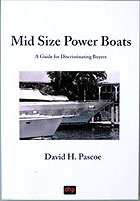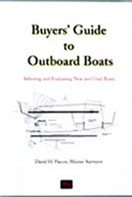Cranchi Mediterranee 40
Express Style Cruiser
by David Pascoe
We were recently asked by a client to do a comparative analysis of several similar boats. The Cranchi 40 was one of them, the other was an Avanti 40 by U.S. Marine. The client didn't know anything about boat quality, but he was interested in getting the best he could. That included not just the eye candy, but the basic engineering as well.
I will confess that I've never been much impressed by Italian boats, which are famous for their "old world craftsmanship," but often fall far short on modern world engineering. Economically, Italy is one of the weak sisters of the European Union, with substantially lower labor rates. Among other things, this makes Italian boats considerably lower priced that American counterparts.
So when the client mentioned Cranchi -- a builder who's products I've never seen before -- I cringed. If you want to know why, just check out the Mochi 50 review on this site. Well, it just goes to show that you can't paint everyone with the same brush because I was pleasantly surprised. Even more so because it's been a while since I've seen anything (short of the really high dollar stuff) that has really caught my attention and interest. I regret that we don't have any pictures for you, but I ran out of film.
People laugh when I tell them that I kick the sides of boat hulls, actually thinking I'm making a joke. I'm not. I really do kick the sides of boats and that's the first thing I did with the Cranchi. With very high spring tides up to within a foot of the dock, there was a lot of hull exposed this time. I now have sore toes. The day before, I kicked the side of another boat and I was horrified that that my foot nearly went through. A 40 footer, the side of that hull could not have been more than 1/8" thick. I could push it in 1/2" with my thumb easily.
It's amazing. No one in their right mind would consider a house built that flimsily. A boat goes to sea, a house doesn't. Go figure.
With only a limited amount of internal hull access, I quickly determined that the engineering that went into this hull was superb. Nothing fancy, they just put some frames in the hull like everyone else should be doing. In fact, the framing was better than anything I've seen in a very long time.
Frames that run down the length of hull sides are called "clamps," hearkening back to the days of wooden boats when we had chine clamps and sheer clamps. In addition to a stiffening liner in the bow section (it's spoon-billed and needs serious framing), there were two 6" half-round frames or clamps running down the length of both sides. The stringers were not massive but 4" wide shallower hat sections outboard, with tall narrow hats inboard. Transverse frames were numerous but smallish glass over ply, as were the major bulkheads. Speaking of bulkheads, not just partitions, either. I would throw my body weight into them and they wouldn't budge. If I did that on some boats, I'd take the partition right out.
The deck is heavily glassed to the hull. All over, and not a single metal fastener. This join is never going to leak. It looks like a real piling crusher instead of the usual other way around. I don't know about you, but I don't like egg-shell boats. I don't like screwing around with fenders. I expect the boat to bump against a piling without causing thousands of dollars worth of damage. These days, it's hard to find one.
The foredeck is well supported by bulkheads below so that it doesn't bounce when you do. The stainless bow rails were uniquely solid and firm. Silver anodized windshield is extra strong, curved with glass, not plastic lites. The non skid is that diamond pattern with the points cut off midway, so it's easier on bare feet, knees and elbows. Also easier to keep clean. It also looks like they opted for a softer gel coat that doesn't stress crack. There weren't any, but oxidizing is a problem. Needs to be polished 2x a year.
The detail work with the engine room and systems was excellent. A lot of integrity here. Of course, it was absolutely no surprise that anyone who would take that much care in building a hull, that they would do everything else right, too. Integrity of effort, or lack of it, rarely ever applies to just one aspect of the overall boat. When the builder starts counting beans, he counts all of them, not just a few. Ergo, if one major aspect is right, it's likely the rest is too.
Unfortunately, with a deep vee hull, they decided to reduce draft by giving it propeller pockets. This forced the engines inboard and created a very cramped engine room when it shouldn't have been. Extremely large fuel tanks set in front of the engines didn't help matters, nor did the low profile of the sheer line which makes the engine room shallow. Engine and engine room maintenance will be problematic here. This boat just happened to have a meticulous owner, so that problem wasn't showing up here.
A lot of high quality plumbing. Braided stainless jacketed oil and hydraulic hoses. Everything neatly laid out. No tangles of wiring, hoses and pipes anywhere. Neat, clean and professional. Like a yacht rather than just a boat.
Europeans have very different ideas about interiors than Americans. It's hard to explain but you know it when you see it. You sort of get the impression that it's sort of like a waiting room, a place where you're not supposed to stay very long. You got all the amenities, but somehow you get the idea that they're really not intended to be used. Layouts are usually not well proportioned, with a whole different emphasis on mode of use. Like heads without showers. Many Euro boats are more set up to be day boats than overnighters.
That is somewhat the case here, though not excessively so. The beam looks to be narrower than most equivalent counterparts, so that's part of the story. It also had one of those "generators in a suitcase." Too small to be serious. Charge the batteries maybe, but turn on the stove and it comes to a screeching halt. The interior has something I've never seen before: molded plastic cabinet doors. What! Did the Cranchi builder own an injection molding company, too? My first reaction was "tacky and cheap," but the scheme fits the decor. At the very least, the material is durable and practical .After a while, it sort of grew on me and I stopped noticing because there's really nothing chintzy about it. It's actually well done and certainly cost a lot to do it. There is no bright wood anywhere on the boat. Insides of all the cabinets are nicely finished. In fact, there is nothing shoddy in any of the places you can't readily see. If you stick your hand into a blind hole, it won't be ripped to shreds by rough fiberglass or anything else for that matter.
The cockpit decking was interesting from the standpoint of it being a bunch of vinyl covered panels attached to an aluminum framing and guttering system. Very different from the usual fiberglass molding, but I'm not sure if that's good or bad. It does have a nice feel when you walk on it, particularly with bare feet. No doubt it also cuts down on engine noise. I haven't a clue as to what's under the wood. Hopefully not plywood. On the other hand, there wasn't a leak anywhere in sight.
It's got big Volvo diesels, horsepower unknown. Volvo doesn't put spec. plates on their engines. We didn't sea trial this boat, so we know nothing about performance. It's got propeller pockets and outboard rudders.
To give you an idea of how well known Cranchi is (They're been around a while) they are not even listed in the BUC book. The original price of this boat is well under most others in its class. At 2.5 years old, the asking is 2/3 rds the original and the boat doesn't have much in the way of extra goodies. The markdown is in keeping with a comparable line of price boats. At the asking, it is remarkably good value for the money. On the other hand, for a 40 footer, it is small; narrower in beam and lower in profile. It's got that Mediterranean look, you know, so you give up a bunch for styling. But what you get in quality is enough to make you think hard about trade-offs.
I could see serious cruising for two, but not for four. Then again, different people have different ideas about the definition of "cramped." Otherwise, it is a high quality day boat with an adequate cockpit arrangement and a nice walk through transom onto the swim platform.
For its class, we'll give it 4.5 stars for a job very well done.
Posted April 8, 1999
 Visit davidpascoe.com for his power boat books
Visit davidpascoe.com for his power boat books 














David Pascoe is a second generation marine surveyor in his family who began his surveying career at age 16 as an apprentice in 1965 as the era of wooden boats was drawing to a close.
Certified by the National Association of Marine Surveyors in 1972, he has conducted over 5,000 pre purchase surveys in addition to having conducted hundreds of boating accident investigations, including fires, sinkings, hull failures and machinery failure analysis.
Over forty years of knowledge and experience are brought to bear in following books. David Pascoe is the author of:
In addition to readers in the United States, boaters and boat industry professionals worldwide from nearly 80 countries have purchased David Pascoe's books, since introduction of his first book in 2001.
In 2012, David Pascoe has retired from marine surveying business at age 65.
On November 23rd, 2018, David Pascoe has passed away at age 71.
Biography - Long version